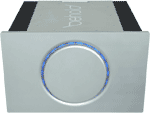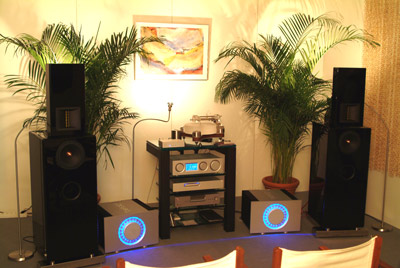Living with Behold’s BPA768 amplifiers and APU768 preamplifier

My Journey into Sound: Part One
Living with Behold’s BPA768 amplifiers and APU768 preamplifier
 It began in 2004, at the winter CES, in the Acoustic Signature/Isophon room, where I first gazed at a static display of two new German digital components, the Bi-Amping Power Amplifier BPA768, and its controller, the Audio Processing Unit APU768. Both have a sampling rate of 768 kHz. Both are manufactured by German newcomer Behold GmbH—whose parent company, Ballman electronica GmbH, builds some of the worlds best network analyzers. Moreover, this is the only amplifier I have seen besides the Tact Audio designs which use a true digital input connection at the amplifier. When I peered at the backs of the BPA and APU, my curiosity turned into envy. The back of the APU is so simple, yet elaborately laid out via its inputs and outputs: each with corresponding blinking lights that indicate signal lock. It is obvious, especially when one looks inside the chassis, that this is a company with a computer background. And since they’ve been designing some of the worlds most elaborate network analyzers over the past 20 years, I wouldn’t designate Behold as exactly a “new” company; rather, they’re an old company with a new direction and aim.
It began in 2004, at the winter CES, in the Acoustic Signature/Isophon room, where I first gazed at a static display of two new German digital components, the Bi-Amping Power Amplifier BPA768, and its controller, the Audio Processing Unit APU768. Both have a sampling rate of 768 kHz. Both are manufactured by German newcomer Behold GmbH—whose parent company, Ballman electronica GmbH, builds some of the worlds best network analyzers. Moreover, this is the only amplifier I have seen besides the Tact Audio designs which use a true digital input connection at the amplifier. When I peered at the backs of the BPA and APU, my curiosity turned into envy. The back of the APU is so simple, yet elaborately laid out via its inputs and outputs: each with corresponding blinking lights that indicate signal lock. It is obvious, especially when one looks inside the chassis, that this is a company with a computer background. And since they’ve been designing some of the worlds most elaborate network analyzers over the past 20 years, I wouldn’t designate Behold as exactly a “new” company; rather, they’re an old company with a new direction and aim.
Neither Class T, D or ICE Powered
 Based on the sheer size and weight, the digitally-based BPA768 certainly wouldn’t qualify as a typical 100 – 150 watts per channel digital amplifier, such as the smaller ICE based Bel Canto or NuForce. Behold’s BPA768 specs read like those from a comic strip of your favorite super hero. “Look, up in the sky…it’s a plane…no it’s Behold!” What most distinguishes the BPA768 is the output stage: 300 watts per channel into 8 Ohms, 600 into 4 and 1200 into 2, of pure, unadulterated old school Class A power, with a regulated (sliding) bias control to conserve energy and keep your neighbor’s lights from going dim. Essentially, the BPA768 runs like a typical Class A design except its digital bias control allows it to consume power along the lines of a typical Class A-B design. The BPA768’s circuitry is very complex, employing 8 high quality cascaded DACs per side (16 in all) designed to manipulate the analogue signal in ways never previously implemented.
Based on the sheer size and weight, the digitally-based BPA768 certainly wouldn’t qualify as a typical 100 – 150 watts per channel digital amplifier, such as the smaller ICE based Bel Canto or NuForce. Behold’s BPA768 specs read like those from a comic strip of your favorite super hero. “Look, up in the sky…it’s a plane…no it’s Behold!” What most distinguishes the BPA768 is the output stage: 300 watts per channel into 8 Ohms, 600 into 4 and 1200 into 2, of pure, unadulterated old school Class A power, with a regulated (sliding) bias control to conserve energy and keep your neighbor’s lights from going dim. Essentially, the BPA768 runs like a typical Class A design except its digital bias control allows it to consume power along the lines of a typical Class A-B design. The BPA768’s circuitry is very complex, employing 8 high quality cascaded DACs per side (16 in all) designed to manipulate the analogue signal in ways never previously implemented.
Fast forward to high End 2004, the M.O.C. in Munich, Europe’s equivalent of the Las Vegas CES. Impressed by the dozens of show rooms that were well setup and thought-out, my fascination for Munich in general and its sights really grew on me. It was while luxuriating in one great sounding room after another that I stumbled into the best room I’ve heard in three years of attendance: the Isophon Europa/Behold GmbH room. Coincidentally, this was the very same room that five months earlier at CES had showed their static display, except this time they were up and running. It was short work to sense how special the sound was. I’ve not heard anything during my four days there that’s sounded more impressive and realistic.
I kept finding myself running back to the Isophon Europa/Behold room, having begun to doubt what I had heard only hours before. And each time I took someone else with me in the expectation they’d tell me the sound of this room was not as good as I thought. I couldn’t find anyone to tell me otherwise. Franck Tchang, the man behind the amazing Acoustic Resonators, was one of those folks I dragged into the room and he too thought it produced the best sound at the show (without his Resonators!). Don Dixon and I spent countless hours in the Isophon/Behold setup. Don informed me confidentially that he thought this was the only room that actually sounded better than my system at home. I was a bit hurt by this remark but when something sounds this good, such remarks are to be expected. Reminded me of my trip to the International Sight and Sound Show in Singapore back in 2000, when I first discovered the sonic merits of an amplifier I awarded Best Sound at Show. That product has since garnered some of the highest recommendations, and measurements (according to John Atkinson) in recent memory, was the Halcro dm68. Equally interesting was the now defunct Arial 10T that was used with the Halcro monoblocks once upon a time served as my reference loudspeaker.
Same with the Isophon Europa. For the life of me, I couldn’t understand how this loudspeaker could sound this good. How good, you ask? It made the Ascendo System M, playing right next door, sound distinctly like the ‘less expensive brand’ (And note that the Ascendo System M lists for $36,000, while the Europa, another excellent German-made floor stander, can be had for about $12,000.) In my home, the Ascendo certainly sounded better than at this show, and at their nearly three-times-the-cost price tag, they better well had (although their designer, Roland Gauder, didn’t think so upon his visit here earlier that year). After hearing the Europas with the Behold electronics, I returned home and for the first time second guessing whether or not I had screwed up in buying the Ascendos (I’ve since learned I had not).

How could something so good sound so bad?
At the 2005 CES, the folks from Acoustic Signature/Isophon had the entire Behold system driving their smaller model loudspeakers. I looked forward to getting everyone I knew into this room to hear what captivated both Don Dixon and me back in Germany. And of course, it wasn’t what I expected. It was a much smaller room and I wasn’t really too impressed. Disappointed? Yeah, I guess you could say that.
The 2005 High End Show, held again in Munich, was a letdown of major proportions. Let me explain. I had stayed in touch with designer and architect Ralf Ballman, who possesses a brilliant mind (remember he builds network analyzers for a living). After a constant stream of email and telephone correspondence, Ballman finally got a chance to hear the Ascendos in his own home, and he thought they were as good as my review had said. He liked them so much, in fact, he decided to show them in Munich with his electronics. Of course I sounded the audiophile alarm. I remember screaming “Ascendo plus Behold? Game Over! Game Over.”


Nothing went as planned. Because Behold had parted with Isophon and Acoustic Signature, they had to seek their own show room. In doing so at this late juncture they got the least desirable room available. The good rooms (like the ones where I first heard Behold) were booked many months in advance. And the show’s growth forced some exhibitors to work out of prefabricated box-like structures made of nothing more than sheet rock nailed onto wood frames. But the rooms at least looked the part in that they were inviting. The Behold group had a way of giving this box a nice aesthetic: dark scenery accented by plants and spot lights. The circular, soft glow from the amplifiers gave an imposing message that said “This isn’t the amplifier your dad used to play with.” But as soon as the music started, so did the room. It shook, expanded and echoed the entire three days I attended. Worse was the effect it had on the system. Everything sounded boomy and tinny at the same time. And of course, once again I had to eat crow. I personally wanted to shoot the people responsible for building dozens of these awful rooms.
One could perhaps understand the less than enthusiastic “Sure” response I gave Ballman when the opportunity finally arrived to review the entire Behold lineup which included two BPA768 amplifiers, a fully loaded APU768 preamplifier, their new CD-Player, and the MCA768 moving coil phono cartridge, Master TQ-1 linear tone arm attached to a Clearaudio Anniversary Edition turntable.
The equipment arrived in the sturdiest of aluminum shipping crates to insure a safe trip and return. Due to a new pair of DALI Megalines replacing the Ascendo System M as my new reference, I had to rethink how to set up the Behold system now that an external crossover (used in the Megalines) entered into the audio equation. First things first. I wanted to hear the difference the Behold system would make, so I ran it first into the incredibly affordable Hyperion 938 loudspeakers to see how difficult operating these intimidating electronics would be. Everything worked like a charm. The system was fully setup and running within 45 minutes – 30 of which were spent setting up the Clearaudio rig.
DeHavilland monos driven by an Audiomecca Mephisto Mk II used as a transport (into the George Mark Audio DAC/preamplifier) sounded beautiful, and had a sense of ease, but it couldn’t convey the body and incredible life-like imagery of the Behold setup right out of the box. In fact things started to become a bit embarrassing for me. All the talk around the house when the fellows came through was “When are the Beholds going upstairs?” This is where my reference DALI Megalines and Tact Audio Boz line of digital amplifiers reside.
![]()
Don’t forget to bookmark us! (CTRL-SHFT-D)
Stereo Times Masthead
Publisher/Founder
Clement Perry
Editor
Dave Thomas
Senior Editors
Frank Alles, Mike Girardi, John Hoffman, Russell Lichter, Terry London, Moreno Mitchell, Paul Szabady, Bill Wells, Mike Wright, Stephen Yan, and Rob Dockery
Current Contributors
David Abramson, Tim Barrall, Dave Allison, Ron Cook, Lewis Dardick, Dan Secula, Don Shaulis, Greg Simmons, Eric Teh, Greg Voth, Richard Willie, Ed Van Winkle, and Rob Dockery
Music Reviewers:
Carlos Sanchez, John Jonczyk, John Sprung and Russell Lichter
Site Management Clement Perry
Ad Designer: Martin Perry





Be the first to comment on: Living with Behold’s BPA768 amplifiers and APU768 preamplifier